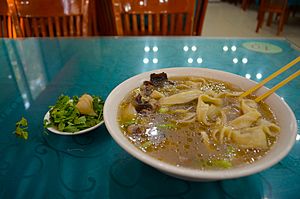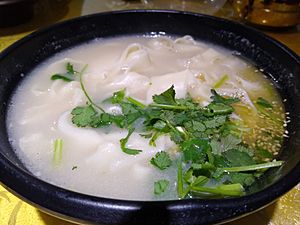Hui mian facts for kids
Hui mian is a delicious noodle soup from Henan, a province in China. It's made with lamb bones that are cooked for at least five hours. This long cooking time creates a special milky white soup! Besides the noodles, you might find other tasty things in your bowl, like kelp (which is a type of seaweed), thin strips of tofu, fresh coriander (a herb), and tiny quail eggs. Sometimes, people add chili oil or minced peppers for extra flavor. The exact ingredients can be a little different depending on the city or restaurant where you try it.
Contents
History of Hui Mian
Hui mian has a very long and interesting history. It's believed to have started way back in the Tang Dynasty, which was a powerful time in ancient China.
How Hui Mian Began
The story goes that a kind woman made Hui mian for Li Shimin. He was a prince at the time, and he was very hungry and tired while trying to escape during a war. The special noodles helped him feel strong again. When Li Shimin became the emperor, he remembered the delicious dish. He found the woman and asked his royal chefs to learn her recipe.
From Royal Secret to Popular Dish
For many years, Hui mian was a secret food enjoyed only by the royal family. Much later, during the Qing dynasty, another important ruler, Empress Dowager Cixi, also ate Hui mian when she was traveling during a difficult time. She even said it helped her feel warm! Eventually, a royal chef named Pang Enfu shared the recipe with regular people. This is how Hui mian became a popular dish for everyone to enjoy in Henan.
Different Kinds of Hui Mian
Henan province is a big place with many people, so there are lots of different styles of Hui mian! Each one has its own special touch.
Yang Fu Yan Hui Mian
Yang Fu Yan Hui mian is a popular style in Henan. It follows the very old, traditional way of making Hui mian. This means they only use lamb and beef to make the soup broth. They don't add pork, which some newer recipes might use.
Heji Lamb Hui Mian
Heji Lamb Hui mian is a special type of Hui mian that follows Halal rules, meaning it's prepared in a way that is allowed by Islamic law. This style started from an old hotel and restaurant in Zhengzhou. In 1953, it became "Heji Restaurant," which means "many people manage together." Since 1967, they have focused on lamb noodles and named their famous dish "Heji Lamb Hui Mian." It has even won awards as a "famous brand name of food" and a "Chinese famous snack"!
Xiaoji Sanxian Hui Mian
Xiao Ji Sanxian Hui Mian is another common style in Henan. The person who started this style, Xiao Honghe, was a chef who made a different kind of noodle called Yifu mian. After he retired, he opened his own Hui mian restaurant with his sons. He didn't just stick to the traditional lamb Hui mian. Instead, he got an idea from Yifu noodles and added "Sanxian" ingredients. "Sanxian" means "three fresh things" and usually refers to a mix of three delicious ingredients. These often include seafood (like shrimp), fungus (like black wood ear mushrooms), and fresh vegetables (like baby bamboos). Today, people use different combinations of seafood, fungus, and fresh vegetables to make Sanxian Hui mian.
Yexian Hui Mian
Yexian Hui mian is known for its delicious lamb hot pot. The noodles are made from high-quality flour, making them smooth and soft. The soup is made from fresh lamb chops and lamb hooves, with special spices. It tastes rich but not too heavy, and it often has a bit of spicy chili oil. This style is very well-known in many towns and cities around its home area.
Junxian Old-fashioned Hui Mian
Jun County is in northern Henan, an area known for growing strong wheat. This means the noodles made here are extra good! The old-fashioned noodles from Junxian are special because of their secret stir-fried stewed noodles and original soup. It's a favorite food memory for many people from Hebi. They often use goat meat, stir-fried with a secret black sauce. The handmade noodles are cooked in a clear broth with mustard and dried shrimp.
Fangcheng Hui Mian
Fangcheng Hui mian started in the early 1980s, inspired by the Hui mian from Zhengzhou. Since Fangcheng has many Hui people and lots of lamb, the noodle makers there created their own unique style. To know if Fangcheng Hui mian is truly authentic, you need to check three things: the soup, the noodles, and the chili oil.
The soup is made by simmering lamb bones and a whole lamb skeleton for hours. This makes the soup thick like milk and the meat super tender. The noodles are made from the best wheat flour, water, and salt. The salt is very important! The dough is kneaded until it's shiny and strong. Then, it's rolled into oval noodles, brushed with sesame oil, and stacked neatly. The chili oil is also very important, like a secret ingredient. It's made with lamb oil and special small red chilies from Fangcheng.
Modern Hui Mian Storage
Thanks to new technology, scientists in Henan have found ways to store Hui mian so it's easy to keep, move, and eat. One of the best ways to keep the taste fresh is by "instant freezing" it. This means you can enjoy Hui mian even if you're far from Henan!



